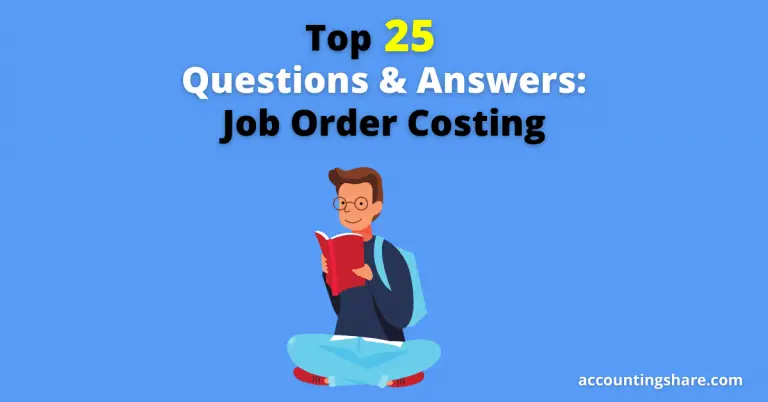Top 25 Questions and Answers-Cost Volume Profit (CVP) Analysis [With PDF]
Cost volume profit (CVP) Analysis has immense importance in management accounting. CVP analysis helps to determine the price of products, planning on profit, and make appropriate decisions.
Today we’ll learn the Top “25” Short Questions and Answers- Cost Volume Profit (CVP) Analysis.” If you read it from start to end, you’ll get the basic idea of CVP analysis. It will also improve your management accounting knowledge and help you do well on any competitive test.
So let’s get started.
Questions and Answers-Cost Volume Profit (CVP) Analysis
Question-01: What’s the cost-volume-profit (CVP) analysis?
Answer: Cost-volume-profit (CVP) analysis analyzes the effects of cost and volume changes on the profits of a company.
Question-02: What is the purpose of CVP Analysis?
Answer: Its primary purpose is to estimate how the following five factors affect profits:
- Selling prices.
- Sales volume.
- Unit variable costs.
- Total fixed costs.
- The mix of products sold.
Question-03: What is the importance of Cost-volume-profit (CVP) analysis?
Answer: Cost-volume-profit (CVP) analysis is essential in
- Planning on profit.
- Setting selling prices.
- Determining product mix
- Maximizing the use of facilities for production.
Question-04: What are the assumptions of the CVP analysis?
Answer: Each CVP analysis underlies the following assumptions.
- The behavior of both expenses and income is linear across the relevant activity range.
- It is possible to classify costs as either variable or fixed accurately.
- The only factors that impact costs are changes in the level of activity.
- All produced units are sold.
- In multi-product companies, the mix of goods sold stays constant.
Question-05: What is the cost-volume-profit (CVP) graph?
Answer: Cost-volume-profit (CVP) graph is a graph that shows the relationship between costs, volume, and profits.
Question-06: What is the CVP income statement?
Answer: A statement that classifies costs as variable or fixed and calculates a contribution margin is the CVP income statement.
Question-07: What’s the Contribution Margin (CM)?
Answer: The contribution margin (CM) is the amount of revenue that remains after variable costs have been deducted. Both as a total amount and on a per-unit basis, it is often stated.
Questions-08: How to calculate the Contribution Margin (CM)?
Answer: Contribution Margin= Total Sales- Variable Cost
Question-09: What is the contribution margin ratio?
Answer: The contribution margin ratio refers to the percentage of sales of each dollar available for fixed costs and net income contributions.
Question-10: How to calculate the Contribution Margin (CM) ratio?
Answer: CM Ratio= Unit Contribution Margin/Unit Selling Price.
Question-11: What are the variable costs?
Answer: Variable costs are costs that differ directly and proportionately with changes in activity levels.
Question-12: What are the fixed costs?
Answer: Fixed costs are costs that, irrespective of changes in the level of activity, remain the same in total.
Question-13: What is the break-even point?
Answer: The break-even point is the level of activity at which total revenues equal total costs (both fixed and variable cost).
Question-14: What’s the break-even analysis?
Answer: The break-even analysis is called the process of finding the break-even point.
Question-15: What are the ways to calculate the break-even point?
Answer: The break-even point can be calculated in the following ways:
- Calculated from a mathematical equation.
- Calculated by using the margin of contribution.
- Derived from a graph of costs-volume-profit (CVP).
Question-16: What is the formula for calculating Break-even Point?
Answer:
Break-Even Point in Units=Fixed Costs/Unit Contribution Margin
Break-Even Point in Dollars= Fixed Costs/Contribution Margin Ratio
Question-17: What is the margin of safety?
Answer: The margin of safety is the difference between actual or expected sales and sales at the break-even point.
Question-18: What is the formula for calculating the margin of safety?
Answer: Margin of Safety = Actual (Expected) Sales-Break Even Sales.
Question-19: What is target Net Income?
Answer: The revenue objective set by management is the target net income.
Question-20: What is the formula to calculate Target Net Income?
Answer: Target Net income=Required Sales-Variable costs-Fixed Costs
Question-21: How to calculate the required sales in units and dollars?
Answer:
Required Sales in Units = (Fixed Costs+ Target Net Income) / Unit Contribution Margin
Required Sales in Dollars = (Fixed Costs+ Target Net Income) / Contribution Margin Ratio
Question-22: What are the mixed costs?
Answer: Mixed costs are costs that contain both a variable and a fixed cost component and change overall, but not in proportion, to changes in the level of activity.
Question-23: What is the High-Low Method?
Answer: The high-low method is a mathematical method used to classify mixed costs into fixed and variable components using the total costs incurred at high and low activity levels.
Question-24: What is the operating leverage? and how to calculate the degree of operating leverage?
Answer: The operating leverage is a measure of net business income’s sensitivity to a specific dollar change of percentage sales.
Degree of operating leverage = Contribution Margin/Net Operating Income
Question-25: What is the sales mix?
Answer: The term sales mix refers to the relative proportions in which a company’s products are sold.
I hope, at the end of the article, you have a basic idea about the cost volume profit (CVP) analysis. Read these Top “25” Short Questions and Answers- Cost Volume Profit (CVP) Analysis and improve your accounting skills.
You may also read:







